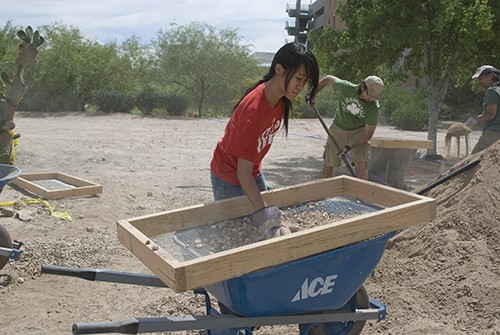Students and community members broke ground on a garden they hope will nourish not only stomachs but also the UA’s relationship to Tucson.
The Associated Students of the University of Arizona’s Students for Sustainability Garden in the Desert team sifted soil and filled crop beds for a garden scheduled to be in full swing next semester.
Students and community members will be able to rent plots to grow whatever they like in the garden, said Sofia Montes, crop production senior and Garden in the Desert team member.
Located on the corner of Mabel Street and Highland Avenue, the garden is situated between Highland Avenue Parking Garage and houses in the Jefferson Park Neighborhood, home of the mini-dorms debate.
“”It’s a perfect bridge-way between the community and the university,”” said Caleb Weaver, Garden in the Desert co-manager and a senior majoring in ecology and evolutionary biology and geosciences.
Montes said she thinks students often get a “”bad rap”” and that she hopes the garden will help them see that “”we’re not all bad folk.””
The garden will also be an educational resource and a place to host workshops, she said.
There will be 47 plots total with most measuring 20-by-3 feet, according to Montes.
The beds consist of native soil, compost and manure, according to Annie Silverman, Latin American studies senior and Garden in the Desert team member.
Some plots will be set aside for production so that the team can sell organic produce to students and the Tucson community.
The team wants the plots to be “”very affordable,”” Montes said, with plots costing no more than $15.
Surrounding the garden will be a “”food forest”” with be edible crops such as fruit trees, Montes said.









